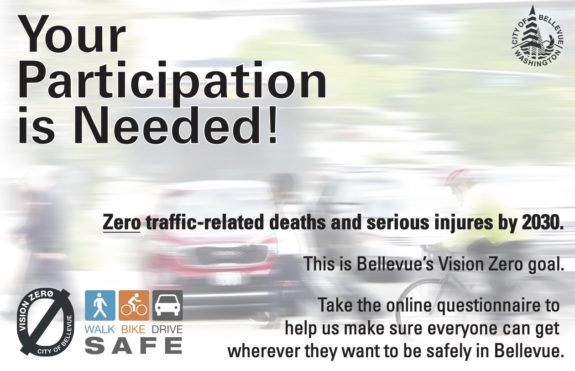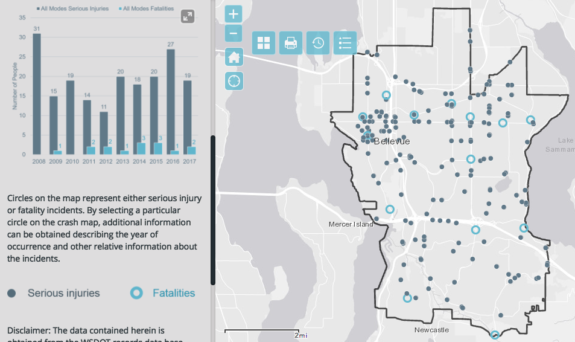
The Bellevue City Council unanimously endorsed Vision Zero in 2015, and now they are putting together an action plan to help eliminate deaths and serious injuries on city streets by 2030.
City staff have put together an online survey to gather perceptions of traffic danger and stories of how traffic collisions have affected people’s lives. The survey walks through some of the basic tenets of Vision Zero, including questions that don’t get asked enough such as whether “it is unacceptable for anyone to be killed or seriously injured while traveling on Bellevue streets” and whether “human life should always take priority over moving vehicles faster.” The survey is probably as much about getting the respondents to think about traffic collisions in a different way as it is about gathering useful data.
But the sad reality is that our culture has thoroughly embraced death and injury on our roads as simply the cost of getting around, and it will take a lot of work to change that. The questions in this survey can’t be asked enough.
So if you live, work or spend time in Bellevue, take the survey and pass it around. Because Bellevue has a lot of work to do to reach this goal, and as with any city it’s going to take both infrastructure and cultural changes to get there.









Comments
4 responses to “Bellevue is creating a Vision Zero ‘action plan,’ take their survey”
Bellevue has started to walk the walk re: Vision Zero. I look forward to seeing many more improvements in the coming years to a city where cycling on some streets used to be only for those with nerves of steel.
I guess it helps to not have a dysfunctional DOT. Yes, SDOT, I’m looking at you.
Bellevue is usually quite serious about what it intends to do, and makes steady progress in doing it. They run into opposition sometimes, and progress can slow sometimes (such as with the Main St. bike lanes east of Bellevue Way) but Bellevue generally does what it intends to do.
In contrast, Seattle is often guided by the loudest complaints.
At the moment, Bellevue is still in a stage where there’s a lot of low-hanging fruit, that is, easy ways to make walking and biking easier without impacting drivers, or spending all that much money.
But, if they’re really serious about vision zero not being “if only everyone would just take a car, we would have zero pedestrian deaths”, they’re going to have to figure out a way to tackle roads like 8th St., Bel-Red Road, Northup Way, 148th Ave., and 156th Ave. Because, if the goal is to unlock commercial destinations like Crossroads Mall, Fred Meyer, and the Microsoft campus (coming from the south), that’s what they’re going to have to do, as these streets have no viable detour route.
Some stretches of 148th, you could almost convert the sidewalk on at least one side of the street into a multi-use trail, but for the most part, there is simply no room to make these arterials bike friendly without either sacrificing a car lane or taking a significant chunk of private property to widen the street. Nor is the Greenway option viable in Bellevue because, for the most part, the non-arterial streets do not go through. For example, try to get from DT Bellevue to Crossroads Mall without using 8th St., or try to get from Overlake Village to Crossroads Mall without using 156th. Unless you’re willing to detour way out of the way, you simply can’t.
Another example is getting from the 520 trail at 108th to the CKC. There’s a bike lane halfway up, but it abruptly ends halfway up the hill, because they decided they needed the space for merge lanes for cars turning out of driveways, instead. They’re
Unfortunately, if you look at Bellevue’s bike master plan, they basically punt on all the hard stuff, suggesting either sharrows or nothing at all. The good news is that, somewhat surprisingly, simply taking the lane of an arterial street does actually feel safer in Bellevue than it does in Seattle, mostly because the drivers tend to be more patient and less aggressive. But this is still not anything close to “all ages and all abilities”.
Until now, they’ve had the excuse that some of the hillier routes people aren’t going to ride on anyway, but with the proliferation of electric bikes, that’s no longer true. For the future, every major corridor, no matter how hilly, needs to be taken seriously as a potential bike route.
asdf2, your assessment is correct. Along with saying that Bellevue’s progress can be slow, I could add that Bellevue is less ambitious than Seattle. They’re not going to make NE 8th St. safe for anyone not in cars.